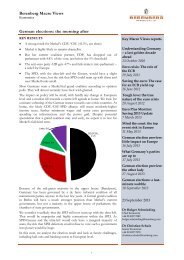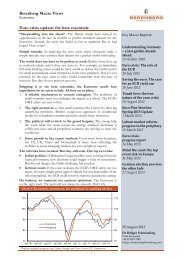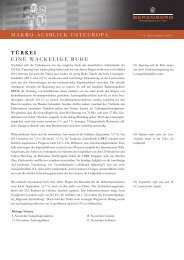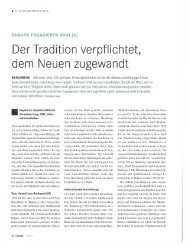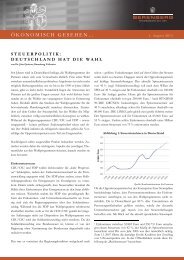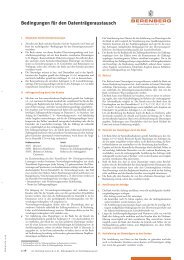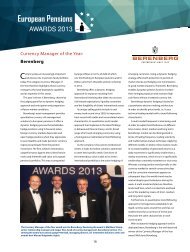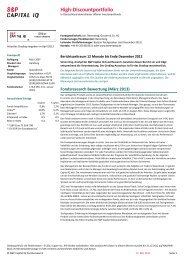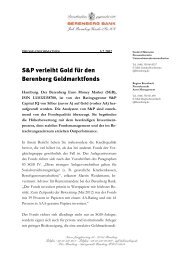Semiconductor Equipment - Berenberg Bank
Semiconductor Equipment - Berenberg Bank
Semiconductor Equipment - Berenberg Bank
You also want an ePaper? Increase the reach of your titles
YUMPU automatically turns print PDFs into web optimized ePapers that Google loves.
<strong>Semiconductor</strong> <strong>Equipment</strong><br />
Technology Hardware<br />
Snapshot on capex trends and vendor exposures<br />
In our view, the capex level of the industry is likely to be flattish over the next two<br />
years (5% up in 2014 and 3% up in 2015), and increase by 10% in 2016 due to<br />
450mm migration, driven by strong foundry/logic and memory spending recovery.<br />
<strong>Semiconductor</strong> equipment vendors’ growth potential differs from one vendor to<br />
another, as they are each exposed to different fabrication processes. We believe<br />
ASML and ASMI are likely to benefit from their sales addressable market (SAM)<br />
expansion, while TEL is likely to suffer from its declining SAM.<br />
Capex to remain flattish in 2014/2015<br />
Memory – NAND capex to return to growth and accelerate in 2014/15<br />
NAND capex is likely to return to growth in 2013 (up 6%) and accelerate in<br />
2014/2015 (up 15% and 20% respectively), driven by the high capital requirements<br />
of 20nm/below node, and 3D NAND.<br />
We believe NAND vendors are unlikely to increase capex significantly in the near<br />
future as they did historically in peak years (39-115% growth), as 1) the spending<br />
pattern has become more conservative since the 2012 trough period, 2) Samsung’s<br />
new NAND fab, Micron’s DRAM-NAND conversion, and Toshiba’s capacity<br />
resumption may provide new capacity in next two years, and 3) the low-/mid-end<br />
smartphone/tablet, which is likely to be the driver for the consumer devices<br />
market, requires less NAND content than high-end products.<br />
Memory – DRAM stable 5% growth in 2013/2014<br />
DRAM capex growth is likely to be stable and grow at 5% in 2013 and 2014,<br />
enabling a limited expansion of 30nm/20nm capacity.<br />
We believe DRAM capex will not increase significantly as: 1) capacity expansion<br />
demand is low (as per our conversations with industry sources, current capacity is<br />
sufficient to support annual bit growth of about 30%); 2) mid-/low-end consumer<br />
devices require less DRAM content per box; and 3) smartphone/tablet DRAM<br />
demand is not sufficient to offset the decline in PC unit growth as the content per<br />
box is less (0.6GB versus PCs at 4.2GB).<br />
Foundry/logic players remain solid, contributing 60% of total capex<br />
Foundry/logic players are heavily exposed to the consumer electronic markets, as<br />
Samsung and Intel manufacture their own chips for their smartphones, tablets and<br />
Ultrabooks, Apple contracts the Samsung foundry and TSMC for its chip<br />
manufacturing requirements and fabless players such as Qualcomm, Mediatek and<br />
Nvidia contract foundries like TSMC, Globalfoundries and UMC for their chip<br />
manufacturing.<br />
As a result of the increasing competition within the consumer electronics market,<br />
the chip-makers/device vendors require the most advanced chips in order to<br />
differentiate their end-products. The foundry/logic players are therefore under<br />
pressure to maintain their technology leadership, and all the major players are<br />
ramping up 20nm in 2013, to be followed by 16/14nm in 2014. We thus believe<br />
foundry/logic spending will remain solid, and will contribute about 60% of<br />
semiconductor capex.<br />
Growth potential differs as market exposure differs<br />
<strong>Semiconductor</strong> equipment vendors’ growth potential differs from one to another,<br />
as each vendor is exposed to different fabrication processes.<br />
We believe the lithography, ALD, epitaxy deposition, process control and 3D<br />
packaging markets have considerable growth potential, driven by node shrinking<br />
and 3D wafer stacking demand, hence ASML, ASMI, KLA and SUSS are likely to<br />
outperform other equipment suppliers. We believe TEL will suffer from its high<br />
10


